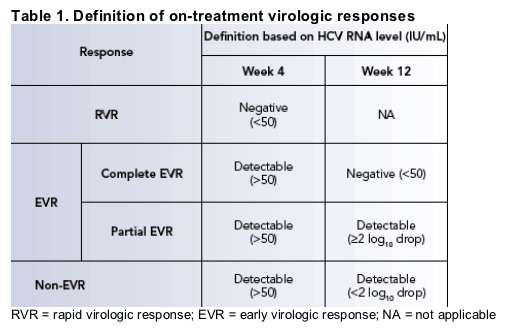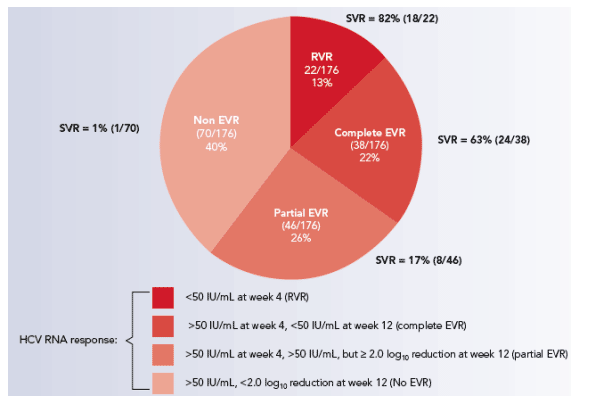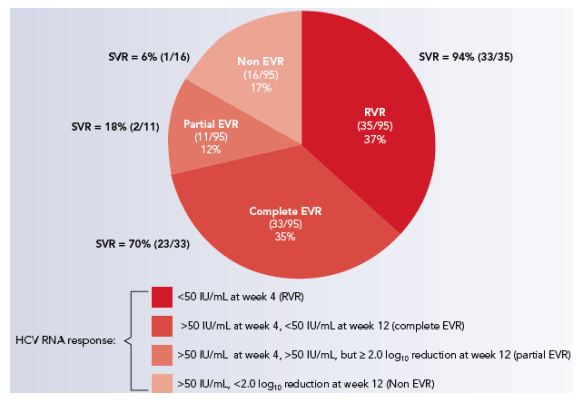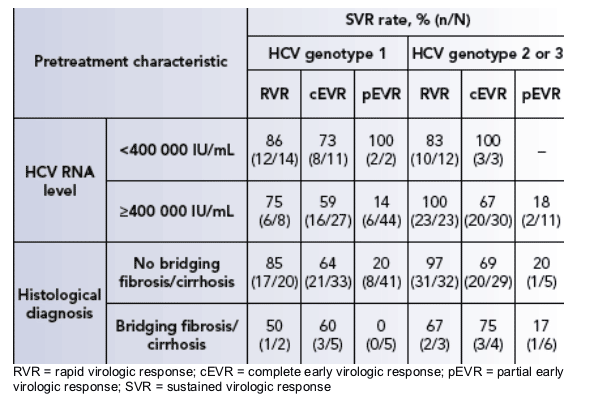 |
 |
 |
| |
Patients co-infected with HCV and HIV who achieve an RVR (HCV RNA <50 IU/mL at week 4) or cEVR (HCV RNA <50 IU/mL at week 12) have similar rates of SVR to mono-infected patients treated with peginterferon alfa-2a (40KD) (PEGASYS) and ribavirin (COPEGUS)
|
| |
| |
Reported by Jules Levin
AASLD, Nov 2-6, 2007, Boston, MA
M. Rodriguez-Torres,1 F. Torriani,2 J. Rockstroh,3 J. Depamphilis,4 G. Carosi,5 D.T. Dieterich6
1Fundacion de Investigacion de Diego, Santurce, Puerto Rico; 2University of California, San Diego, CA, USA; 3University of Bonn, Bonn, Germany; 4Roche, Nutley, NJ, USA; 5Universita Degli Studi di Brescia, Brescia, Italy; 6Mount Sinai School of Medicine, New York, NY, USA
This research was funded by Roche, Basel, Switzerland.
CONCLUSIONS
Approximately one third (34%) of patients infected with HCV genotype 1 and more than two thirds of those infected with HCV genotype 2 or 3 (72%) enrolled in APRICOT cleared HCV RNA from serum by 12 weeks of treatment with peginterferon alfa-2a (40KD) plus ribavirin.
HIV-HCV co-infected patients who achieve an RVR at week 4 or cEVR at week 12 of treatment with peginterferon alfa-2a (40KD) plus ribavirin 800 mg/day have a high chance of achieving an SVR, irrespective of HCV genotype.
Fewer HIV-HCV co-infected patients achieve an RVR or cEVR when compared with HCV mono-infected patients. However, the overall SVR rate in patients with HCV genotype 1 and an RVR or cEVR (70%) in APRICOT is similar to that in patients with HCV mono-infection treated with the same combination in two large phase III trials (73%).[3]
Studies are needed to evaluate response-guided therapy in HIV- HCV co-infected patients. In particular, the effect of intensified treatment in patients without an RVR or cEVR would be of interest.
INTRODUCTION
Patients with HIV-HCV co-infection have more rapid progression of liver disease and a lower probability of sustained virologic response (SVR) than patients with HCV mono-infection.[1]
In APRICOT, the largest trial of HCV treatment in HIV-HCV co-infected patients, the combination of peginterferon alfa-2a (40KD) plus ribavirin produced an overall SVR rate of 40% (29% in those infected with HCV genotype 1; 62% in those patients infected with genotype 2 or 3).[2]
In patients with HCV mono-infection, the virologic response at week 4 and 12 of treatment is increasingly being used to guide therapy decisions (response-guided therapy).
OBJECTIVE
The objective of this analysis is to determine the relationship between on-treatment virologic responses at week 4 and 12 of treatment and SVR rates at the end of follow-up.
METHODS
Patients
Adult patients eligible for APRICOT were required to have HIV-1 infection confirmed by the presence of anti-HIV antibodies or HIV RNA in serum.
Patients with CD4+ cell counts ≥200 cells/mm3 were eligible regardless of HIV RNA level; those with CD4+ cell counts between 100 cells/mm3 and 199 cells/mm3 were eligible if their serum HIV RNA level was <5000 copies/mL.
Patients were not required to be on antiretroviral therapy (ART) at the time of enrollment. If taking ART, they were required to have been on a stable regimen for at least 6 weeks. If not on ART, they were required to have been off treatment for the previous 8 weeks.
With respect to their HCV disease status, patients eligible for APRICOT were required to have quantifiable serum HCV RNA (≥600 IU/mL), elevated ALT levels in serum, a biopsy result consistent with the diagnosis of chronic hepatitis C, and
compensated liver disease.
The complete inclusion and exclusion criteria and study design of APRICOT have been described elsewhere.[2]
Treatment
Patients included in this analysis were those who were randomly assigned to 48 weeks of treatment with peginterferon alfa-2a (40KD) 180 _g/week plus ribavirin 800 mg/day.
Outcomes
Virologic responses at week 4 and 12 were divided into four mutually exclusive categories (Table 1).

SVR was defined as undetectable HCV RNA (<50 IU/mL) at the end of a 24-week untreated follow-up period (week 72).
Rates of SVR were determined as a function of response to therapy at weeks 4 and 12.
RESULTS
A total of 289 patients were included in the intent-to-treat analysis, of whom 271 patients were infected with HCV genotype 1, 2, or 3.
Overall, 21% (60/289) of patients achieved an RVR by week 4 of treatment, 26% (74/289) of patients had a complete EVR (cEVR), and 21% (61/289) of patients had a partial EVR (pEVR) by week 12 of treatment.
The distribution of SVR rates by the on-treatment virologic response are presented in Figure 1 for patients infected with HCV genotype 1 and in Figure 2 for patients infected with HCV genotype 2 or 3.
Figure 1. Virologic responses at week 4 and 12 in HIV-HCV (genotype 1) co-infected patients treated for 48 weeks with peginterferon alfa-2a 180 _g/week plus ribavirin 800 mg/day in APRICOT.

The rate of SVR was highest in patients who had cleared HCV RNA at week 4 or 12 of treatment.
_ The rate of SVR was highest in patients achieving an RVR (82% in those infected with HCV genotype 1 and 94% in those infected with HCV genotype 2 or 3).
_ Among patients with a cEVR, the SVR rate was 63% in those infected with genotype 1 and 70% in those infected with HCV genotype 2 or 3.
Figure 2. Virologic responses at week 4 and 12 in HIV-HCV (genotype 2 or 3) co-infected patients treated for 48 weeks with peginterferon alfa-2a 180 _g/week plus ribavirin 800 mg/day in APRICOT.

The rate of SVR was lowest in those with detectable HCV RNA at week 12 (i.e., in those with a pEVR or non-RVR; Figures 1 and 2).
Among patients with an RVR or cEVR, the rate of SVR was highest in those with a low pre-treatment HCV RNA level (<400 000 IU/mL) and in those without advanced fibrosis (Table 2).
Table 2. SVR rates according to on-treatment virologic
response, baseline HCV RNA level, and histological diagnosis.
From Jules: Of note, SVR rates are high if RVR is achieved. In particular, if there is no bridging fibrosis/cirrhosis, 85% of genotype 1 and 97% of genotype 2/3 patients with RVR achieve SVR, but if bridging fibrosis/cirrhosis is present even with RVR rates of SVR are only 50% in genotype 1 and 67% in genotype 2/3; the number of patients with bridging fibrosis/cirrhosis are small but this suggests starting therapy before disease progression is important, starting therapy early in coinfection is important to achieve good response.

REFERENCES
1. Alberti A, Clumeck N, Collins S, et al. Short statement of the first European Consensus Conference on the treatment of chronic hepatitis B and C in HIV co-infected patients. J Hepatol 2005; 42(5): 615-624.
2. Torriani FJ, Rodriguez-Torres M, Rockstroh JK, et al. Peginterferon alfa-2a plus ribavirin for chronic hepatitis C virus infection in HIV-infected patients. N Engl J Med 2004; 351(5): 438-450.
3. Marcellin P, Jensen D, Hadziyannis S, Ferenci P. Differentiation of early virologic response (EVR) into RVR, complete EVR (cEVR) and partial EVR (pEVR) allows for a more precise prediction of SVR in HCV genotype 1 patients treated with peginterferon alfa-2a (40KD) (PEGASYS) and ribavirin (COPEGUS).
Poster presented at the 58th Annual Meeting of the American Association for the Study of Liver Diseases. November 2-6, 2007.
|
| |
|
 |
 |
|
|